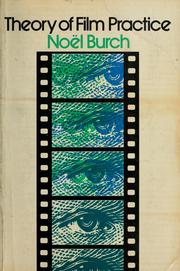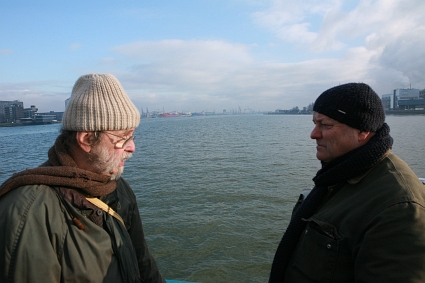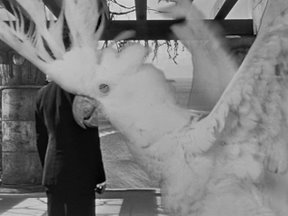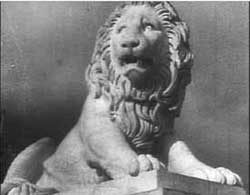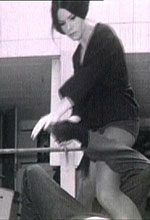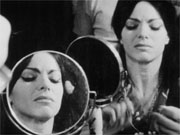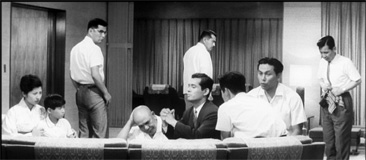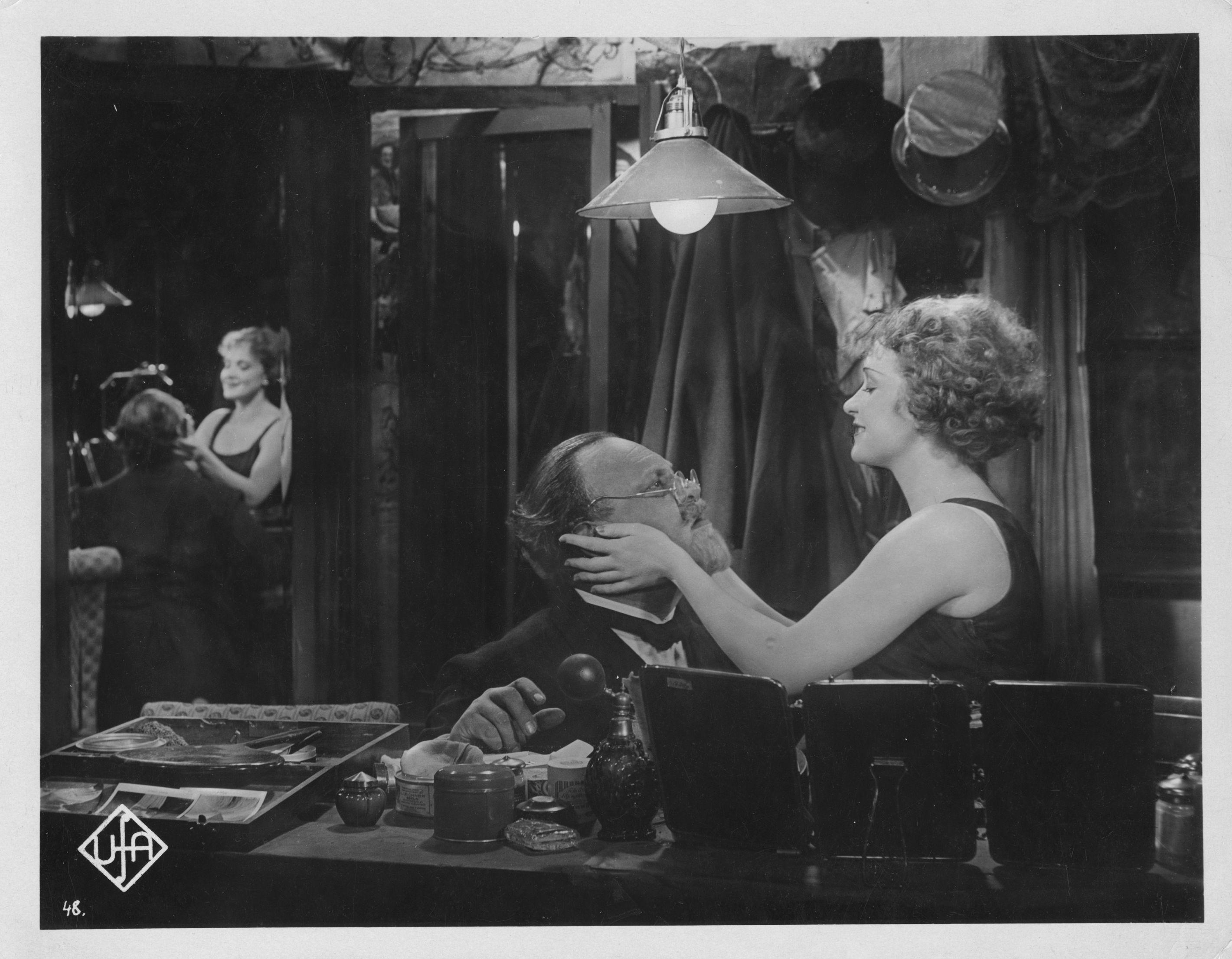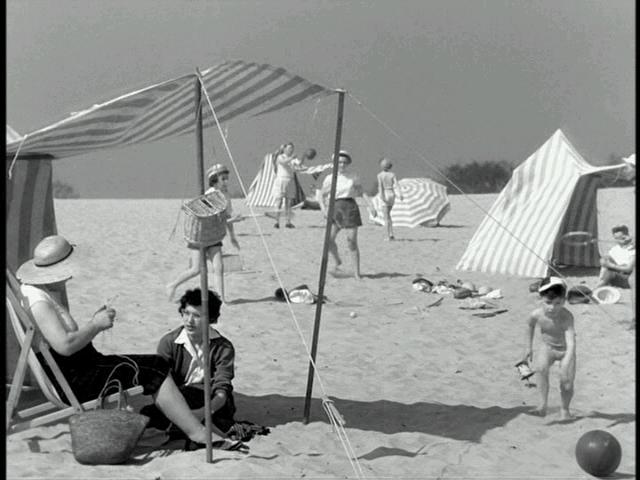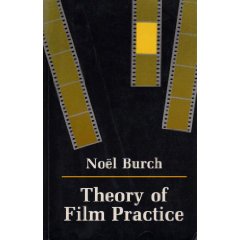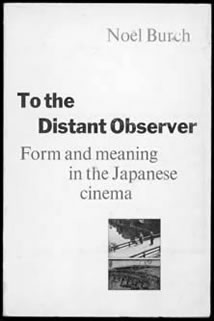This book review appeared in the Winter 1974/5 issue of Sight and Sound. For illustrations, I’m including a contemporary photograph of the author, Noël Burch (seen here in Rotterdam with the late Allan Sekula) and two stills from Burch’s first and (probably) best film, Noviciat (1964 — only 18 minutes long, but including illustrations of a remarkable number of the formal procedures described in his book.
Shortly after this review appeared, I recall receiving a gratifying fan letter of sorts from James Leahy, a teacher at the Slade School in London and a devoted Burch disciple, at least at the time. — J.R.
THEORY OF FILM PRACTICE
By Noël Burch
Translated by Helen R. Lane
Secker & Warburg, ₤3.50 (paperback, ₤1.90)
“Theory of Film Practice is at every point derived from and confirmed by the perception that film develops not through the contraints and coventions of an industry, but in opposition to them.” Thus Annette Michelson, in her exemplary introduction to this revised and updated English edition of Praxis du cinéma (1969), sets forth one salient fact about Noël Burch’s seminal work that clearly isolates it from the critical mainstream as we know it today.
There are many others: a total rejection of the illusionist principle which was expanded in depth by André Bazin (more precisely, extended into deep focus), and has subsequently been adopted as an unexamined postulate by most of his epigones; a ‘scientific’ approach that rigorously eschews journalism, sociology, literary analysis and the promulgation of moral concerns, however much it reflects Burch’s own aesthetic predilections; above all, an obstinate insistence on regarding films as sounds, images and the formal relationships between them.
A redefinition of the components of film form is the task that Burch has set himself: an endeavor vastly more ambitious and far-reaching than anything of its kind to be attempted since the death of Eisenstein. Like Eisenstein, Burch treats film viewing and film-making as parts of the same integral process; and bypassing over two decades of anti-Eisenstein rhetoric — all of it fundamentally illusionist — he re-establishes the shot transition as the cornerstone of formal articulation in cinema.
The first three chapters take us directly into the heart of this matter. Continuous and discontinuous forms of cutting — called respectively “matches” and “mismatches” — and the various uses of off-screen space are defined and investigated at length. Parameters explored in the remaining seven chapters include softness and sharpness of focus, lighting contrasts, moving and stationary images, long and short sequences, structural uses of sound, functions of chance (a fascinating chapter), and an interesting category designated as “structures of aggression”, in which delineates a tradition stretching from Un Chien Andalou and La Sang des Bêtes to Marcel Hanoun and Bergman, by way of Keaton, Langdon, Tex Avery and various Japanese directors. This list of topics is by no means exhaustive; it is worth noting, however, that neither is Burch’s. An inquiry into paramters of acting — a central factor in the recent films of Rivette — is noticeably lacking, and undoubtedly there are other lacunae as well.
Yet the material to be found in this deceptively short book is rich and penetrating indeed, and in early every case the procedure singled out is far from the obvious textbook exhibit (e.g., the stone lions in Potemkin, the cockatoo in Citizen Kane). Each example is a genuine discovery: the crucial function of off-screen space in Renoir’s Nana, chiefly made evident by the actors’ entrances into and exits from the frame; permutations of the positions occupied by the actors from one shot to the next in the first half of Kurosawa’s High and Low; the subtle and dramatic integrations of sound effects with music in Mizoguchi’s The Crucified Lovers; the remarkable “structure of variations” in the opening and closing of doors in the dressing-room complex of The Blue Angel, controlling what is audible or inaudible from the music hall; the deliberate rhythmic alternation between “strong”, active and eventful moments, and “weak”, empty and boring ones in Mr. Hulot’s Holiday, with each sequence composed as an independent “cellular” unit; the progression of Lang’s M from “temporally and spatially autonomous” shots to “an increasing use of the continuity cut, finally culminating in the famous trial sequence in which temporal and spatial continuity are strictly preserved for some ten minutes.” Each of these examples suggests not only an underlying pattern which is relevant to the film at every level (thematic, dramatic and psychological as well as ‘technical’), but a central insight into how the film as a whole works.
Offering lessons in how to look and listen, Burch is practically without peer in making legible the procedures that ordinarily escape the layman’s attention — especially in those illusionist contexts where an audience’s absorption in actors and plots banishes the means by which they are being articulated to the realm of invisibility, distraction, or mere window dressing. For this reason alone, it is hardly surprising that Burch’s book has been summarily dismissed or ignored by ‘mainstream’ critics and filmgoers since its appearance in English over a year and a half ago. Fundamentally at odds with the bulk of what appears in Sight and Sound, Positif, Film Comment, and comparable publications, it implicitly threatens the ground that most cinephiles walk upon. Using examples from figures as diverse as Hitchcock, Antonioni, Fuller, Bresson, Welles and Ozu, Burch proceeds under the firm (if perenially unpopular) notion that “a complete reading of artistic process, including the conscious perception of form, is a liberating activity.”
As Burch suggests in his preface to this edition, a lot of alteration and refinements have taken place in his theoretical work since these essays were written in 1967. An idiosyncratic study of Marcel L’Herbier (Seghers, 1973), important contributions to Afterimage #4 and #5, a brilliant analysis of Lang’s German films in Cinéma: Théorie, Lectures (Klincksieck, 1973) and two forthcoming books — “a study of the concept of form in Japanese cinema” and “a history of the development of Western film language from 1895 to 1935” — all give some indication of the changes in emphasis and direction. But however outdated much of the book appears to Burch today, as evidenced by the countless self-critical footnotes peppering this edition, it unquestionable remains a book years ahead of its time, particularly in an Anglo-American context. And for anyone interested in following Burch’s development — which has since expanded to incorporate semiological and Marxist methodologies — it is an ideal and obvious starting point.
One must protest, however, the shabby treatment this English text has been given by its publishers. Quite apart from the use of a production still from Lang’s You Only Live Once on the cover of the English edition — odd indeed considering Burch’s disdain for Lang’s American films, and scarcely relevant to anything inside the book — the copy-editing of the text frequently borders on the risible. To misappropriate a few of Burch’s terms. the Introduction momentarily creates “two kinds of space” by referring to an analysis of a film (Baby Face Nelson) that isn’t even cited in the text, the footnotes to the final chapter are a series of “mismatches” (after an earlier footnote introduces us to one Millar Gavin), while the demented index — which offers us True Confessions and a mysterious chap named Edmond Genet, but omits dozens of important references to films and film-makers, including every mention of Tati and Dreyer — can only be regarded as a “structure of aggression”.
JONATHAN ROSENBAUM

